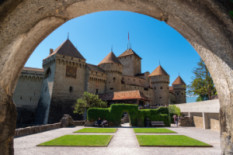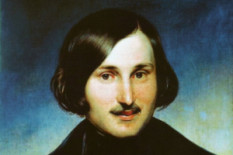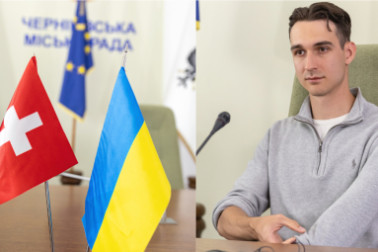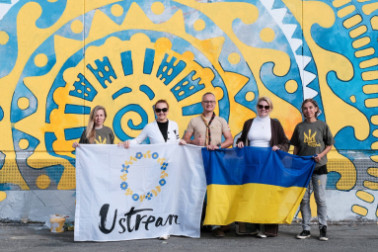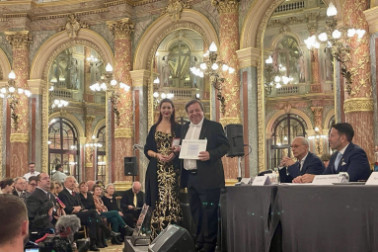Polina Raiko, along with Maria Prymachenko, is a representative of the trend of Ukrainian naive art. She had an incredibly challenging family life which was the impetus for her heartfelt art - art brut, which is characterized by frankness and emotional openness. Raiko expressed her pain in her work. "I am happy only when I paint," the artist often used to say.
Wall paintings by Polina Raiko are a special kind of art. Having painted her own house, which went on to become a museum, she managed to tell not only her own story, but also describe the culture of her native land and the entire generation.
 Complicated fate of Ukrainian women
Complicated fate of Ukrainian women
Polina Rayko was born on May 15, 1928. She worked on a collective farm. She got married at the age of 22. Mykola Raiko became her husband. Later, a daughter was born to the couple, and two years later, a son. The family built a large house in a picturesque place on the banks of the Dnipro.
 Polina Raiko with husband
Polina Raiko with husband
She didn’t pick up a paintbrush for the first time until the age of 69. The impetus for creativity was a personal tragedy - the artist's daughter died in a car accident. A year later, she also lost her husband. Instead, Raiko's son, who struggled with alcoholism, was violent towards his mother and stole the family’s property and sold it. He finally ended up in a prison. He later died from a complication of his addiction – liver cirrhosis.
The woman tamed the pain of losing her loved ones through her work. She found solace in decorating her own home with fantasy plots. Raiko drew one of the fragments of the painting from her own wedding photo. Her husband is there in the afterlife, but she prepared him alcoholic drinks and a fishing rod, which he could not buy during his lifetime.
Another fresco with wedding motifs was also found. The artist hid it on the wall behind the bed. It is not known for sure who is depicted in the photo, she or one of her children. The bride is depicted with a bouquet of flowers and a crown on her head, and angel wings behind her.
Raiko painted with the cheapest paints, which are usually used to paint the floor. She spent her entire pension on materials for creativity. The ceiling and walls became her first "canvases". After that, the artist painted the gates, the fence, the garage door and the summer kitchen. She liked to be alone on the bank of the Dnipro, listen to birds singing and talk to fish. Local residents considered her an eccentric. Fearing prejudice and ridicule, she showed her creativity to only a few people.

Fantastic beasts and their owner
A special place in Polina Raiko's wall paintings occupies birds. Ducks, roosters, geese, woodpeckers, owls. Several times she painted a black crow that steals chicks from the nest. Perhaps in the image of a bird, the woman personified the bitter misfortune that took away her own children.
The artist also liked to draw leopards. Large fluffy animals with unusual features attracted the attention of guests. But Raiko really didn't like it if her leopards were called cats.

Her art combined Christian and pagan symbols. All of the artist's work is imbued with personal experience and reflect her vision of the earthly and otherworldly dimensions.
Art became an opportunity for her to reflect her inner fears and experiences and to overcome loneliness. The artist died at the age of 75 in 2004. She devoted the last six years of her life to painting and, creating a wonderful world within the walls of her own home, which still fascinates connoisseurs of naïve art even today.

Exposure of modest talent
After the death of the artist, her home, which was turned into an art space, was purchased by a couple from Canada. Patrons Andrew Nemitskas and Olena Kosharna saved the building from demolition. A local historian of the Kherson region, Serhiy Dyachenko, was the pioneer of the woman's art. Later, popular artists Vyacheslav Mashinskyi, Olena and Maksym Afanasyeva, and Stas Volyazlovskyi joined him. Through joint efforts, the name of Polina Raiko became well-known in artistic circles.
The team from the Ivan Gonchar Museum, led by the director of the National Center of Folk Culture, conducted extensive esearch on the artist's murals and filmed a documentary. That was followed in 2006 by Documentary director Nadiya Koshman who immortalized the artist in her film "Paradise".
Fragments of Polina Rayko's paintings were reproduced at the Art Arsenal in 2012 as part of the project of the Nebo gallery by curator Marianna Julai, artist Boris Yeghizaryan and photographer Konstantin Rudeshko, in 2019 at the PinchukArtCentre at the exhibition "Your Space" by Tetiana Zhmurko, Tetiana Kochubinska and Anna Cracks
In the summer of 2023, an exhibition of the works of the artist "Polina Raiko. Missing", was organized by the prominent National Center "Ukrainian House" in cooperation with the Charitable Foundation named after Polina Raiko.
.jpg)
A lost heritage
For several years, the Polina Raiko Charitable Foundation took care of the house-museum with the participation of Vyacheslav Mashnytskyi and Semyon Khramtsov. In 2022, after a full-scale invasion by the Russian Federation, the Kherson region was under occupation. Mashnytskyi did not leave the Kherson region to protect the exhibits of the Kherson Museum and Raiko's work. However, shortly before the occupation, relatives and friends lost contact with the artist. To this day, his whereabouts are unknown.
Tragically on June 6, 2023, Russian troops blew up the Kakhovka HPP dam, causing an environmental and humanitarian disaster. After the water receded, Semen Khramtsov published a photo from which it became clear that the inner walls of the house had collapsed. Polina Raiko's unique wall paintings have been almost completely destroyed.
Raiko’s wall painting had became a parallel reality for the artist. Her, amazing birds, animals and angels personified family and friends who she capture in murals to keep close by. Their destruction in the war is not only a terrible loss to Ukrainian culture but again symbolic of the damage done to the natural world and people of this wonderful country.
